Browse: 1470 objects
© Sackler Library, courtesy of the Oxford Digital Library and University of Oxford Department of Oriental Studies "Digitization of Champollion and Rosellini" project
- Reference URL
Actions
Engraving of a Portrait of Amenhotep II, from the Temple of Amada Giuseppe Angelelli
-
Curator’s description:
Description
The print shows an Egyptian man standing in profile, accompanied by identifying hieroglyphs in a cartouche. He is Amenhotep II (reigned c.1426-c.1400 BC), as portrayed in the sanctuary of the temple at Amada (Porter & Moss, "Topographical Bibliography", 2nd ed, Oxford (Clarendon Press & Griffith Institute): 1960-1999, vol. VII, p. 70).
The image is one of six such portraits in one plate forming part of a series representing the kings and queens of ancient Egypt, and is taken from the first volume of plates from Ippolito Rosellini's "Monumenti dell' Egitto e della Nubia", published in 1832. It was first catalogued by Ruskin in the "Catalogue of Examples" of 1870, as no. 16 in the Educational Series, where he entitled it "Egyptian costume". However, it did not reappear in any of his subsequent catalogues, and so was not part of the collection transferred to the University in the Deed of Gift of 31 May 1875. Whilst Ruskin noted that it was from plate 17, it was Cook and Wedderburn (XXI.61) who identified it as figure 6, presumably on the basis of Ruskin's instruction to 'draw the spotted head-dress very carefully'. As it can no longer be found, it is represented here by a plate from the volume in the Sackler Library of the University of Oxford.
The draughtsman identified as 'L' cannot be identified with certainty: he may have been either Nestor L'hôte or Charles Lenormant.
In a note in "The Ethics of the Dust", explaining how the individual aspects of the Egyptian deities were still largely unknown, Ruskin was somewhat sceptical of Rosellini's qualities: 'for the full titles and utterances of the gods, Rosellini is as yet the only - and I believe, still a very questionable - authority' (Ethics of the Dust, note III = XVIII.363). In his entry below nos 176-180 in the Reference Series, Ruskin again questioned Rosellini's accuracy, noting that the colours were sometimes conjectural, 'slight traces of the original pigments, and those changed by time, being interpreted often too arbitrarily' (Standard and Reference Series catalogue, p. 22).
-
Details
- Artist/maker
-
Giuseppe Angelelli (1803 - 1849)Giovanni Paolo Lasinio (1789 - 1885) (engraver)
- Object type
- Material and technique
- watercolour and bodycolour over engraving in red and black ink on wove paper
- Dimensions
- [260 x 141 mm (approx., stone)]
- Associated place
-
- Africa › Egypt › Nubia › The Temple of Amada › The Temple of Amada (subject)
- Inscription
- Both engraved:
above the image: 6
below the image: A. DA L.
- Provenance
-
Recorded in the Ruskin Drawing School (University of Oxford), in 1870; not recorded in the collection subsequently.
- No. of items
- 1
- Accession no.
- EXAMPLES.ED.016.a
-
Subject terms allocated by curators:
Subjects
-
References in which this object is cited include:
References
Ruskin, John, Catalogue of Examples Arranged for Elementary Study in the University Galleries (Oxford: Clarendon Press, 1870), cat. Educational no. 16
Rosellini, Ippolito, I monumenti dell' Egitto e della Nubia: Disegnati dalla spedizione scientifico-letteraria toscana in Egitto: distributi in ordine di materie, 12 (Pisa: Presso N. Capurro, 1832-1844), pt I, Tavole, pl. XVII, fig. 6
Ruskin, John, ‘The Ruskin Art Collection at Oxford: Catalogues, Notes and Instructions’, Edward T. Cook and Alexander Wedderburn, eds, The Works of John Ruskin: Library Edition, 39 (London: George Allen, 1903-1912), 21
Location
-
- not found
Ruskin's Catalogues
-
Ruskin's Catalogue of Examples (1870)
16. Egyptian costume. B, C, &c., the same. Rosellini, Tavole, tom. i. pl. 27.Draw the spotted head-dress of 16 very carefully, observing how pleasantly grouped and varied the spots are; in vulgar work they would be placed without thought. The more you can copy of these figures the better, always measuring with precision.





